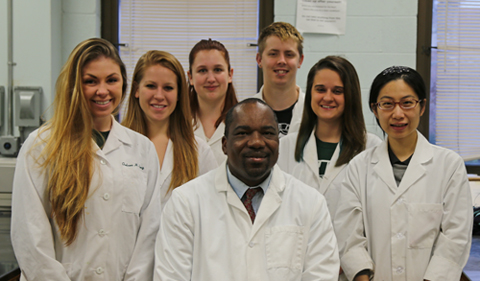Ohio University’s forensic chemistry students are now No. 1 in the nation—with the top toxicology score on the recent Forensic Science Assessment Test administered by the American Board of Criminalistics.
It’s a dramatic jump that helped take OHIO’s forensic science undergrad program from one of the lowest scores to a top-three program overall in just three years.
It’s a prestigious ranking on a short list of acclaimed universities with accredited undergrad forensics programs participating in the national exam. And getting there took a few changes in OHIO’s toxicology course.
FSAT is administered to forensic programs that are accredited by the Forensic Science Education Programs Accreditation Commission (FEPAC). The test helps to see how schools are performing in getting materials to their students and how they fair against other programs. Schools that have participated in the FSAT in the past include Penn State (undergraduate and graduate), Georges Washington University (graduate), and Arcadia University (graduate).
When Dr. Jules Guei, Lecturer in Analytical and Forensic Chemistry, arrived in fall 2012, OHIO was ranked 11 out of the 13 universities on the toxicology portion of the FSAT.
It was time for a little metabolic change in the toxicology course.
What Changed?
“Well, several things,” says Guei, starting with more emphasis on the metabolism of drugs—cocaine, methamphetamines, marijuana, opiates, heroine—as well as redesigning the teaching technique itself in CHEM 4850/5850 Forensic Chemistry.
“I redesigned the toxicology course by emphasizing the biotransformation (metabolic conversion of chemicals to more water-soluble substances which are readily excreted from the body) of xenobiotics (chemicals that are foreign to the body) and by introducing drugs of abuse,” he says.
“I combine practical application of real toxicology, meaning drug analysis, with relevant videos and news articles in addition to the lectures. And I emphasize the biotransformation (i.e. metabolism) of drugs of abuse, which is a major part in toxicology.”
“It’s probably one of the better courses I’ve taken here,” said Shawn Altier ’16, a Forensic Chemistry major with minor in Japanese. “I really enjoyed it. It’s very interesting; the way drugs interact in the body.
“In toxicology we talked about marijuana and how it reacts it the body, and what specifically happens from a chemical standpoint. I just kind of enjoy that part of toxicology. And poisoning is my second favorite. We talked about arsenic poisoning and all sorts of stuff. That was probably my favorite,” Altier said.
“We actually had to do a report for this class, and I chose to do it on poisonings and overdoses on drugs, just partially because of his course. He’s a good teacher, but don’t tell him I said that!”
A Program on the Rise
In 2012, OHIO ranked 11 on toxicology and 10th overall out of 18 schools.
In 2013, after his first year of teaching the course, OHIO raised its toxicology ranking to 8th, and the overall program was ranked 15 out of 16 schools.
Now in 2015, OHIO is ranked No. 1 on toxicology, and the program is ranked 3 out 13 schools. OHIO also ranks No. 1 on questioned documents and drugs. Questioned documents is part of CHEM 4840/5840 taught by Guei and Dr. Peter Harrington, Professor of Chemistry & Biochemistry.
“With the epidemic of heroin on the rise, this is a very good news to have Ohio University’s toxicology in the front row sit of forensic programs,” adds Guei.
Different from Pharmacy or Medical School
“The way we teach our toxicology is geared toward drugs of abuse. If you go into pharmacy school, they will teach toxicology different from what we teach in the forensic department. If you go into medical school, it will be different from what we teach in the forensic department. We gear our toxicology here toward toxicology principles, toxicity testing, biotransformation of xenobiotics, and chemistry of drugs of abuse. Instruments such as GC-MS, FT-IR, ICP-OES, ICP-MS, and Raman are routinely used in our lab.”
- Gas Chromatography–Mass Spectrometry (GC-MS) is an instrument used to analyze a specific compound based on the vapor pressure.
- Fourier Transform Infrared Spectrometer (FTIR) is used to determine the molecular “fingerprint” of substances.
- Inductively Coupled Plasma Mass Spectrometry (ICP-MS) is used for the analysis of trace elements in samples.
Noticeable drugs studied in the course include alcohols, cannabinoids (including Δ9-tetrahydrocannabinol, the principal active ingredient in marijuana), amphetamines/sympathomimetic amines, cocaine, opiates/opioids, etc. “As I continue to develop the course, the next addition will include sedative-hypnotics (Xanax, etc.) that are frequently involved in human poisoning according to the America Association of Poison Control Centers (AAPCC) annual reports,” adds Guei.


















Comments